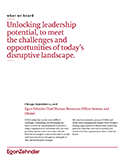Unlocking Leadership Potential, to Meet the Challenges And Opportunities of Today’s Disruptive Landscape
Egon Zehnder Chief Human Resources Officer Session and Dinner
CHROs today face an ever more difficult challenge – identifying and developing the talent to drive the transformation required in today’s organizations, individuals who can solve problems quickly and in new ways, with the fortitude to navigate in uncertainty and to accept and overcome failure through an onslaught of data and marketplace changes.
We recently convened a group of CHROs and senior talent management leaders from Chicago’s leading organizations to discuss what leadership potential looks like, and how to identify and unlock it in their organizations. Here is what we heard:
The New Era of Talent Spotting
Throughout human history, there has always been a need to effectively identify the right talent for the endeavor at hand. At the dawn of civilized living, leaders were chosen for their physical attributes – namely strength and dexterity – that would increase the odds of survival in a harsh environment. The next era sought superior intelligence as the driver of new and innovative ideas and business strategies; the third emphasized particular leadership competencies and experiences; and today, we’ve add another dimension to competency based assessment and have ushered in the fourth era – identifying and developing leadership potential.
Defining Leadership Potential
The most effective tool at the CHRO’s disposal is understanding how an individual’s inherent leadership potential – not just an evaluation of their competencies and past performance – can change a culture and unleash new possibilities for each person and the company. At Egon Zehnder we define potential as a measurable combination of four traits: curiosity, insight, determination, and engagement. We’ve developed a model for quantifiably assessing these traits in leadership recruiting, development and retention strategies. When we understand an executive’s potential, we can calculate how far that person can grow in functional competency beyond their current state, if they utilize their full potential. Read more about the importance of assessing for leadership potential in our feature story in the Harvard Business Review: 21st Century Talent Spotting.
Winning the War for Talent
Assessing for leadership potential is catching on as one of the only ways to forecast which individuals will successfully navigate the permanently disrupted environment in which we now live. But it can be hard for organizations to transition to this method of assessing talent largely because of the way we have been conditioned to make people decisions. We are hardwired to look at the same data points – namely, past performance and experience – and make judgements based on those pieces of input, even when we are wrong up to 50% of the time. Adopting an approach to hiring and development based on potential changes the equation, mitigating the risk of unsuccessful people decisions.
The Diversity/Potential Connection
Potential plays a role in identifying and even more importantly – retaining – diverse talent. Many companies find that even well-de ned diversity strategies don’t make the impact they hope they will. In part, this is because of unconscious bias – we are evolutionarily conditioned to be fearful of people who look or act different from us and to trust people who are more like us. In business this means generations of male business leaders remain wired to trust other men when developing successors and talent. Focusing on measurement of potential replaces our gut instincts and identities a broader, more diverse pool of talent; which is incredibly important given that most orgs are already fishing in the same very small diverse talent pool. Read more about the importance of authentic diversity initiatives that will retain the high potential diverse talent already within your organization – a valuable asset your competition will benefit from if you don’t invest in keeping them: Rethinking Risk in Developing and Retaining Diverse Executives.
How Much is Enough?
It is possible to identify how much potential is required to help someone achieve a level of competence to become a qualified CEO; how much for a qualified C-suite exec and roles one level below the C-suite.
According to insight gleaned from thousands of assessments for high potential, a preponderance of people have enough of some combination of the four traits to become the latter; and a fair amount show enough to achieve success in the role of CEO. Our research in this area shows there is a massive waste of talent inside firms who are hiring most of their senior talent – particularly CEOs – from outside. These companies either can’t support their high potentials to reach it, or they are still weighting experience and competencies higher than potential.
Job Rotations and Stretch Assignments Unleash Potential
PotentialStretch assignments and job rotation – not formal training – are often the greatest contributors to executives realizing their potential. A company-wide job rotation program will keep talent moving throughout the organization and create leaders with multifaceted perspectives who are able to adapt quickly to new challenges. Read more about the important role of job rotations, including exposure to global markets through international postings, in developing leaders who can lead in disruptive, challenging and fast-paced environments – the new normal in business today: Transforming in a Disrupted World.






